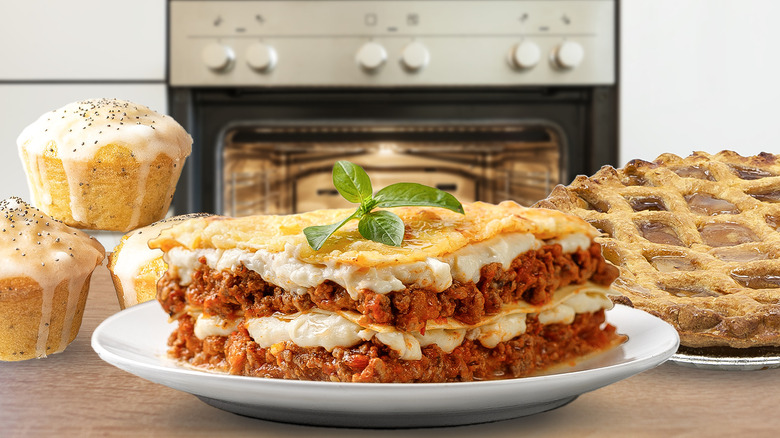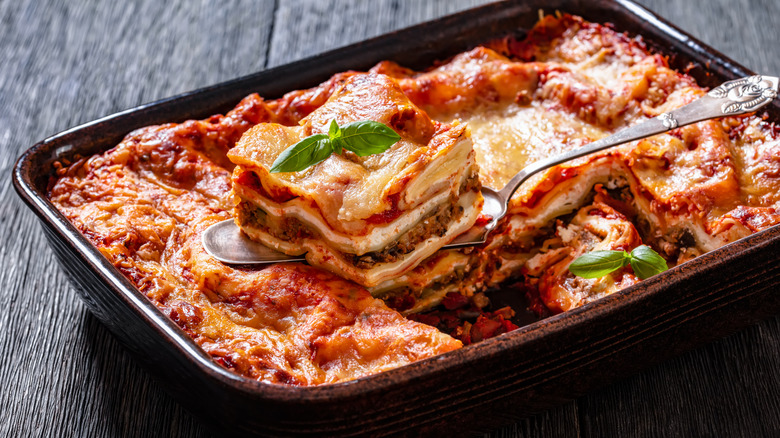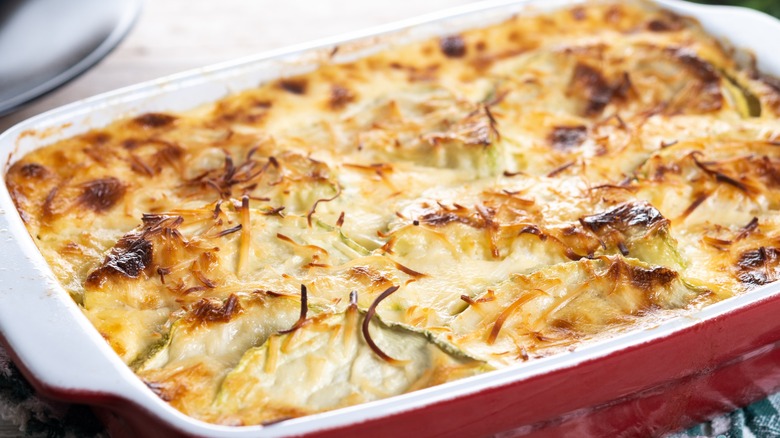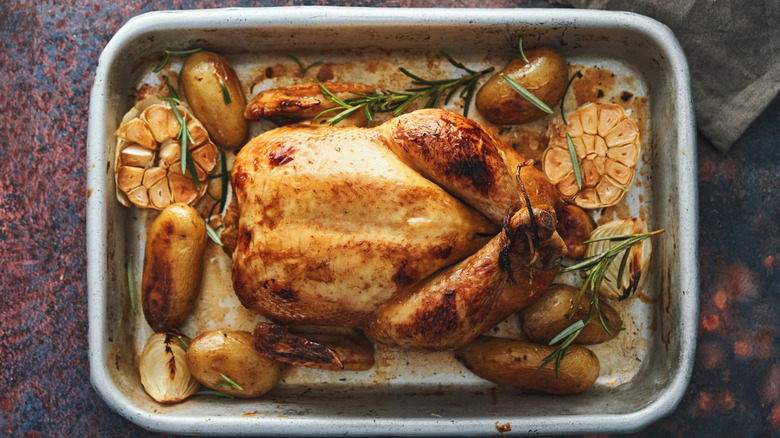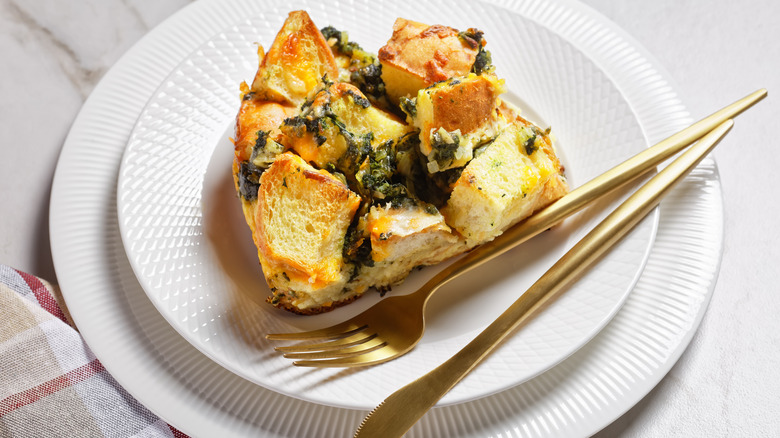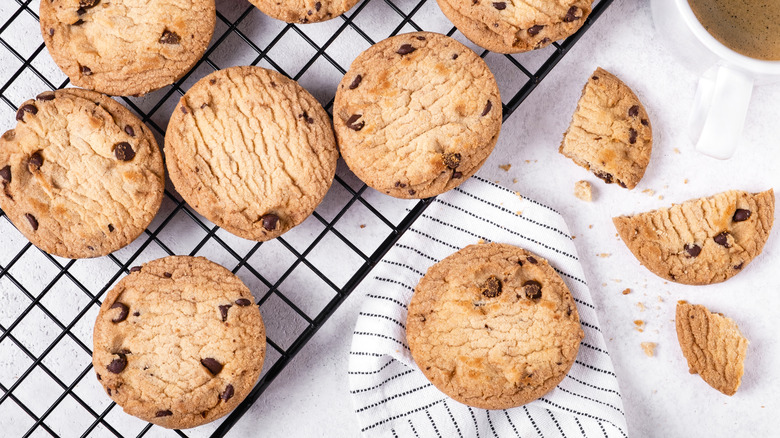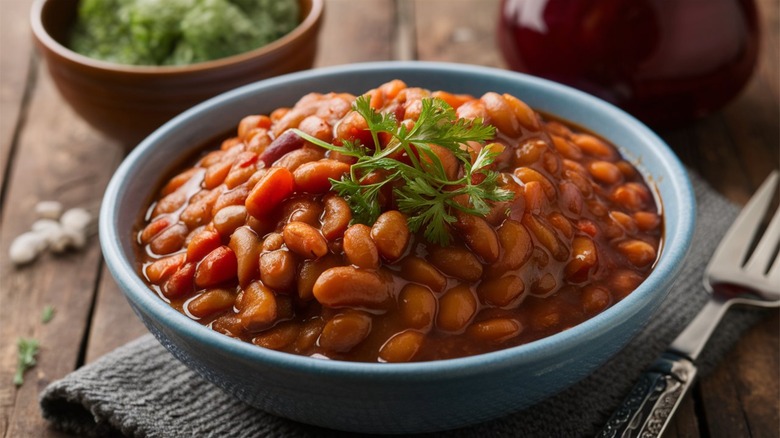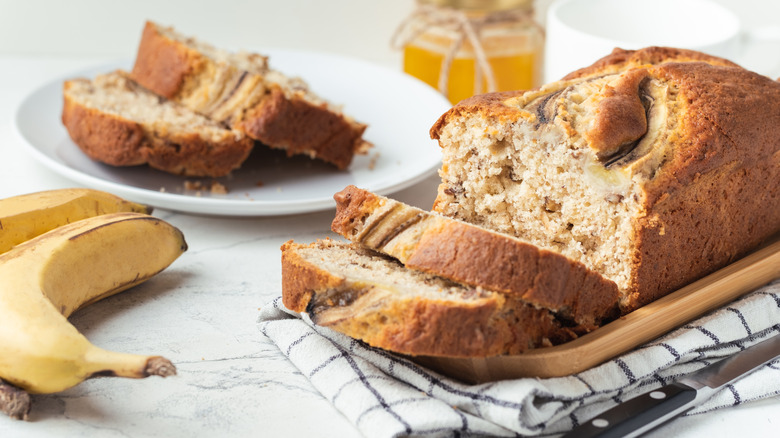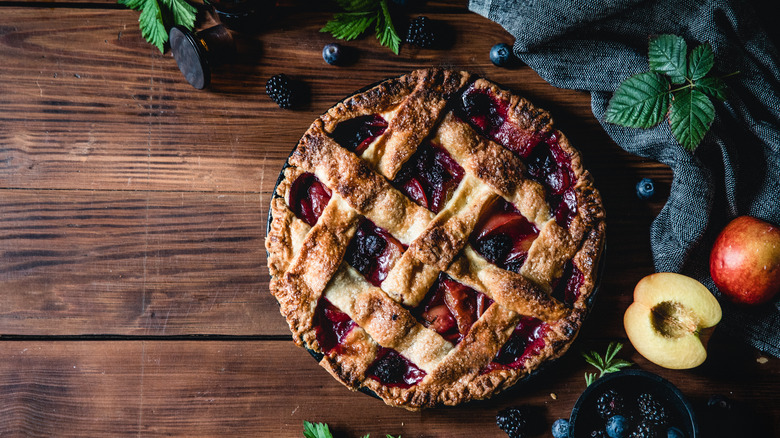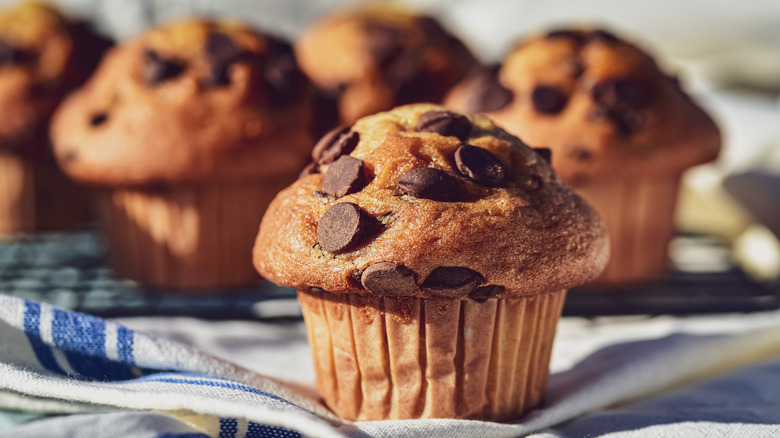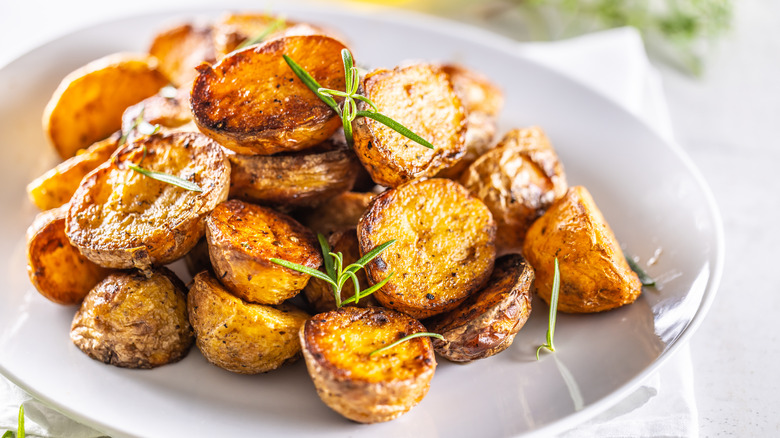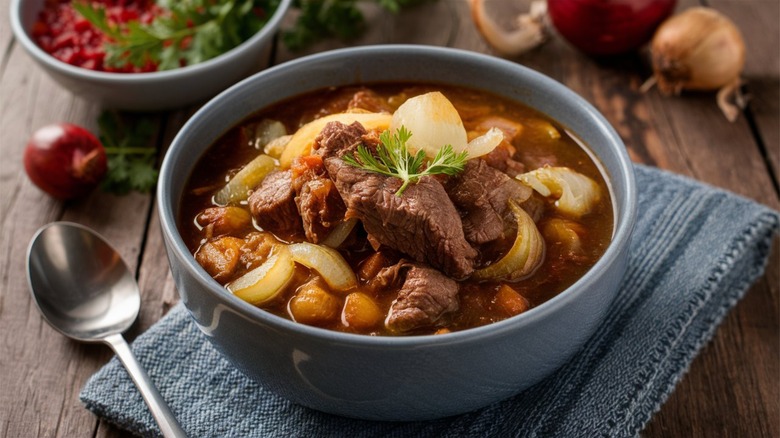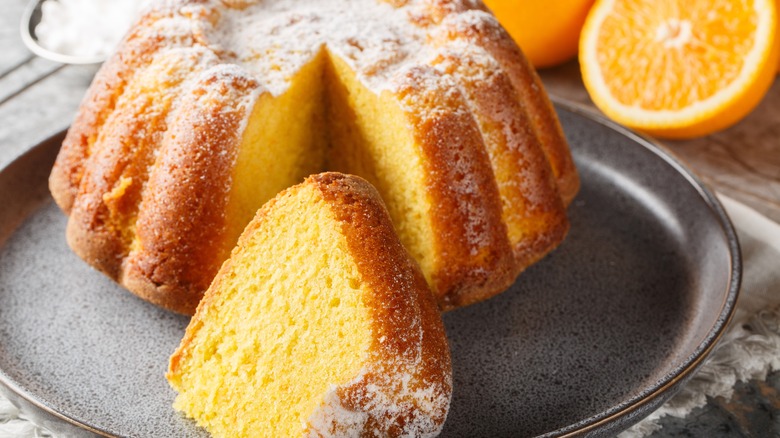13 Dishes That Don't Require A Preheated Oven
For many of us, preheating the oven is a nonnegotiable step when it comes to cooking. Whether simply out of habit or to ensure success for certain dishes, the first step in any recipe that uses the oven is to let it heat up properly. However, there are times when we may get too caught up in our prep and forget to preheat the oven, forcing us to put things on hold until the oven reaches the right temperature, or when we simply want to whip things up in a hurry but have to account for the extra time it takes for things to heat up.
Despite what you may be used to, a preheated oven is not always necessary, and a lot of dishes allow you to skip this preliminary step completely. Indeed, though it may seem counterintuitive, placing your food into a cold oven is oftentimes perfectly suitable — and at other times actually beneficial — providing you with better results than a hot oven.
From hearty and saucy dishes that benefit from gentle and gradual cooking to baked goods that exhibit better rise and ideal textures, there is a range of dishes that can be made without a preheated oven, with no compromise on taste or texture. If you're looking to cut back on your energy use or simply want to slash the tedious waiting time that accompanies the traditional step, cold-oven cooking may just surprise you as an efficient, economical, and incredibly effective method.
Mac and cheese
Before mac and cheese even enters the oven, it is essentially ready to eat, with the pasta being boiled beforehand and mixed into a pre-prepared, creamy, cheesy sauce. In fact, the dish can be cooked from start to finish on the stovetop, but baking it in the oven helps to thicken up the sauce, alongside crisping up any crumbly toppings you may wish to add for an extra touch of decadence. Indeed, baking your mac and cheese is the best method to guarantee a richer, more cohesive dish where the sauce and pasta bind and meld together beautifully. And because the best approach is low and slow, a preheated oven is by no means necessary.
Prepared mac and cheese can be placed in a cold oven, and it will gently cook as the oven heats up, with the cheese melting slowly and the pasta absorbing all the creamy goodness of the sauce. Though the end result will no doubt be as good as that which has been baked in a preheated oven (if not better thanks to potentially more uniform cooking), a quick finish under the broiler may still be beneficial if you're looking to achieve a nicely golden top and a slight crunch.
Lasagna
Much like mac and cheese, lasagna benefits from a slow bake, whereby the pasta has time to meld with the rich and juicy tomato sauce and the layers intertwine beautifully. Thicker, deep-dish lasagnas with multiple layers may thus fare better starting off in a cool oven. A hot oven can brown the top layers and the corners of the dish too quickly, before the middle layers have time to cook and fuse with each other properly, which may result in an uneven bake. Though a crisp top is delicious, it's likely better to turn the heat up at the end for a golden top, instead of risking an underbaked middle and overcooked outside.
Starting in a cool oven works for both traditional meat-based lasagnas as well as vegan alternatives, such as those made with tofu, mushrooms, or lentils. So long as the lasagna is baked for long enough that the cheese has time to melt and the ingredients and flavors in the filling have enough time to develop and blend together, you will no doubt end up with a tender and moist pasta bake. You might find that the lasagna needs a little longer to bake all the way through (you can check if all layers are cooked properly by inserting a knife and making sure it slides through the entire bake with ease), but the extra time likely won't outweigh the time you save by not preheating the oven.
Casseroles
Thanks to their versatility, casseroles are a beloved staple in many kitchens, easily assembled with whatever ingredients you may have on hand. As it turns out, these handy one-pot dishes are more convenient than you may have thought, not requiring a preheated oven to deliver the reliable warm and comforting results that they are known for. Since casseroles consist of a mix of ingredients, sometimes in layers, tossed together in a single dish, there's no real technique or complicated cooking processes needed to bring everything together, aside from allowing enough time for all components to meld together. A non-preheated oven lends itself well to this process, with a gradual increase in temperature ensuring that the entire dish is cooked gently and evenly, without the top layers or edges becoming overcooked or dry before the middle is properly cooked.
You can easily slash the time it takes to get dinner on the table by cooking your casserole in a cool oven, especially if you've prepared the dish in advance. Casseroles are a very forgiving dish, making them an optimal contender for a cold start. All you'll really need to do is keep an eye on it as it cooks and adjust your timing a little if necessary.
Roast chicken
Chicken — particularly the leaner parts of the bird such as the breast meat — has a propensity to dry out, especially when roasted or cooked at high temperatures. Fortunately, there are multiple steps you can take to help your roast chicken stay moist, and this includes cooking the bird at a lower temperature for a longer period of time. Starting in a cold oven and introducing a consistent and steady increase in heat can help to render layers of fat and skin on the outside of the chicken whilst ensuring that the inside stays perfectly juicy. This method of cooking is akin to that which is used to produce rotisserie chickens, with characteristic easily shreddable dark meat and succulent white meat, for truly mouthwatering results.
If you prefer your chicken with crispy skin, consider increasing the temperature towards the end of the roasting, being mindful not to leave the bird in for too long and dry out the tender meat you've thus far maintained. However, the low and slow approach yields such tasty results, especially for chickens with thicker skins or more fat, that even if you are partial to a bit of crunch, you likely won't miss it.
Strata
Strata is a type of breakfast casserole that consists of eggs and bread combined with an array of optional other ingredients, including meat, vegetables, and other add-ins. Made in a similar way to bread pudding (which also fares well starting out in a cool oven), strata is prepared by soaking leftover bread in a mix of eggs, milk, and optional seasonings, before the infused bread is layered with more liquid and optional additions such as bacon, onions, and herbs, or classic combinations like ham and cheese. The prepped dish is then left to soak in the fridge for a few hours, or preferably overnight, which allows for the liquids to properly permeate the bread and for all the flavors to mingle, and is then cooked later on.
Much like any casserole, the process for cooking strata is incredibly simple; just pop the premade dish into the oven and let it bake until the bread is puffed up and golden brown and all of the add-ins are cooked through, employing extra caution when using meat. For an even swifter hands-off approach, you can place your strata directly in the oven without preheating it, and the results will still be delicious, with a perfectly even bake and well-developed flavors. So when you're prepping strata in the evening, ready to enjoy it this next morning, you can enjoy a little extra lie-in with the knowledge that you don't need to wait for the oven to heat up before baking.
Cookies
A fresh batch of cookies is hard to resist and even harder to be patient for. If, in the haste of preparing your dough, you forget to preheat the oven, there is no need to wait for it to heat up — you can start baking your cookies in a cold oven. Drop cookies, in particular, may actually benefit from a cooler start as they expand at a more controlled and even rate, limiting the risk of the dough spreading out into a puddle-like shape and colliding with other cookies. You may even find that you end up with an all-round more evenly baked cookie thanks to the gradual and gentle temperature increase. A few minutes of extra baking time may be required, but you shouldn't notice too much of a difference. If you prefer your cookies moist and chewy, you can simply remove them before they start to crisp up.
Though you should have minimal issues baking most cookie doughs in a non-preheated oven, those made with high amounts of fat or butter, such as shortbread, may be best reserved for a preheated oven. A buttery dough might struggle in a cold oven, as the butter is at risk of melting and seeping out of the cookie before steaming, leaving you with dry and overly crumbly results. It's best to stick to recipes that don't have a heavy fat content if there's a chance you'll be placing them in a cool oven.
Baked beans
A classic British breakfast food that's enjoyed at various mealtimes across the world, baked beans are a hearty and classic comfort food that's easy to prepare. Saturated in an herby, sweet, and sometimes spicy sauce, baked beans are best cooked slowly, whereby the beans are gently and tentatively softened and the liquid has the opportunity to reduce down and imbue the beans with all of its flavors. As such, baked beans are perfectly suitable for cooking in an oven that has not been preheated, where they will gradually be cooked by the liquid as it thickens and bubbles. Any extra time required only adds to the depth of flavor and unctuousness that this dish is so well-loved for.
Besides taking a more measured and moderate approach to heat, there are multiple ways to take your baked beans to the next level. You could add pork for an umami kick and extra sustenance, caramelize your onions before adding them, and use fresh herbs to garnish for an extra tasty boost.
Quick bread
If you're unfamiliar with the term "quick bread," it generally refers to any type of bread that is made without yeast. The dough, which does not require proofing or kneading, is granted its rise by chemical leavening agents, which in turn slashes the amount of preparation time needed. Indeed, the dough can be baked immediately after mixing, providing you with a finished loaf far faster than other mixes made with yeast or sourdough starter. Moreover, quick bread truly lives up to its name by not requiring a preheated oven to rise. A gentle start actually gives the leavening agents, like baking soda, more time to do their job, providing a light and airy loaf. The crust of the bread may also form more gradually, resulting in an all-around more even bake with a tender exterior and a perfectly fluffy interior.
Quick bread can be made into both sweet and savory varieties, producing a fine and fairly crumbly texture like a muffin. Our lemon and almond quick bread is the perfect recipe if you're looking to whip up a subtly sweet bake that can be served at breakfast time with a generous slather of fruit jelly or enjoyed on its own as a delicious afternoon pick-me-up.
Fruit pies
The combination of crisp pastry and a sweet, fruity filling is pretty hard to top, making fruit pies — like our warming Dutch apple pie — a go-to dessert for many. You can have your pie, bubbling and golden, on the table quicker by not waiting around for the oven to heat up. Although the pastry used for pies is buttery, which can be somewhat problematic in a cold oven if you're looking for a successful rise, this does not prove to be too much of an issue for fruit pies. For fruit pies, the major concern is a crisp, golden brown top and a succulent, sweet filling.
Baking your fruit pie in a cool oven can actually help you achieve better cohesion between the filling and the crust by giving the liquid time to bubble and thicken and any larger pieces of fruit time to soften before the crust becomes overcooked or dried out.
Muffins
In a similar way to quick breads, muffins benefit from a gradual heat increase, able to achieve a higher rise than when placed in a preheated oven. This is because baking powder, a typical leavening agent used in muffins, is activated by liquid. In a wet batter, the baking powder is most potent, and thus the longer the batter remains moist, the more the baking powder can do its job and inflate the mix. When muffins are put in a cool oven to bake, they stay wet for longer, and the baking powder has more time to push them up before they set, resulting in a more impressive, likely more well-domed rise.
Our maple and walnut muffins are a great choice for either a speedy breakfast or a tasty snack and are ready in just 15 minutes — no need to turn on the oven beforehand. Or, for something a little more indulgent, our death by chocolate muffins recipe is the optimal treat if you're looking for a little touch of luxury without hours of prep.
Roasted potatoes
With a light and fluffy interior and a crisp, moreish exterior, roast potatoes are one of the ultimate side dishes. A suitable pairing for a variety of entrees and ingredients, crunchy roast potatoes have the ability to steal the show when prepared properly, with a delectable crunch and inviting golden color being qualities to strive for. As it turns out, an oven that has not been preheated may not only be suitable for this purpose, but may, in fact, help you achieve the texture that you're after.
Much like how you should boil potatoes in cold water to start so that the outsides of the potatoes do not get scorched before the insides are completely cooked, roasting potatoes in an oven that starts cold can help to ensure even cooking — a goal that can sometimes be a challenge thanks to potatoes' density. As the oven, and subsequently the potatoes, begins to heat up, they start to steam slowly from within, which is the key to achieving a delicate and fluffy interior. As they continue to cook, the outsides crisp up, providing the ideal combination of crunchiness and softness.
Stews
Most dishes that are cooked in a liquid will fare just fine in an oven that has not been preheated, which makes stews an excellent contender. Although most stews can be simmered on the stovetop, letting them cook in the oven often provides better results thanks to a better distribution of heat. When stews are cooked on the stovetop, the heat is concentrated at the bottom, which can cause uneven cooking, especially if it is a particularly large batch. The oven, by contrast, surrounds the dish with heat coming from all directions, cooking everything not only more uniformly but also quicker. An oven that starts cool is even more beneficial, as the gradual increase in temperature increases allows for the liquid to simmer gradually and reduces the risk of any ingredients being boiled, which can produce tough and chewy results.
Meats, especially those with a decent amount of fat, benefit particularly well from being cooked at a lower heat for a longer period of time, making recipes such as our old-fashioned beef stew an excellent option for cooking gently in an originally cool oven. Without a sudden blast of heat from a hot oven, the meat is given a chance to break down and tenderize without drying out. Beef, for example, can be braised beautifully in an oven that has not been preheated so long as the braising liquid is simmering.
Pound cake
Like muffins and quick bread, most sponge cakes that are made with a chemical leavening agent will work well when starting out in a cold oven, being granted extra rise and even developing a thinner and more delicate texture. However, for guaranteed stellar results, pound cake should be your go-to when prepping a cake for a cool oven. As it turns out, using a cold oven is a hack for achieving perfect pound cake, with the extra time given to the leavening agents resulting in a fluffier crumb, beautiful golden crust, and a taller height than pound cake cooked in a conventionally preheated oven.
Its versatility and adaptability make pound cake an excellent choice for a dessert that is sure to please, able to be customized and elevated with the inclusion of various toppings and accompaniments. Additionally, its simplicity makes it a breeze to prepare, notwithstanding that it can be placed directly into a cold oven and will still yield ideal results. So, if you need a dessert in a hurry, let this be your sign to try cold-oven pound cake and taste the difference for yourself.
